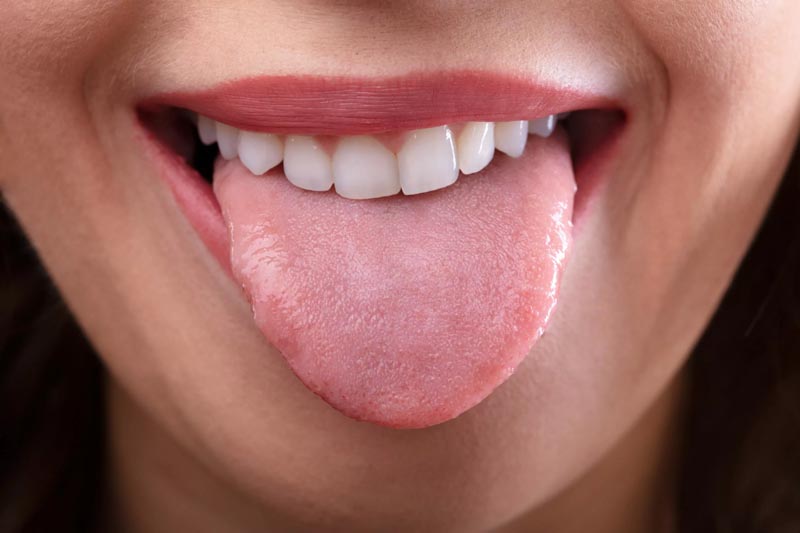Your Tongue Is a Good Indicator of Health

Your mouth is an extremely complex part of your body with many working parts. While your teeth and gums receive a great deal of attention, your tongue is equally as important. After all, it’s the organ that allows you to speak, eat, and taste all the wonderful flavors your food has to offer from spicy salsas to sweet desserts.
However, your tongue can also help your dentist or doctor uncover unknown health conditions. A normal, healthy tongue should be pink with a layer of small bumps or nodules, known as papillae, along the surface. These papillae contain roughly 9,000 tastes buds, which provide us with the ability to taste different flavors, ranging from sweet and sour to salty and savory.
If your tongue’s appearance begins to deviate from this look or you experience feelings of pain or discomfort, there may be an underlying issue. Why else do doctors ask you to open your mouth wide at the beginning of exams? They are examining your tongue to get a quick look at your health. If your tongue is discolored or has bumps or growths, it may indicate an underlying health issue.
White Coating or Spots
As we have already mentioned, your tongue should be a warm, pinkish color. While it is natural for there to be a thin white layer over it, a strong white coating or white spots may indicate one of many things.
- Oral Thrush: Oral Thrush is often found in infants and the elderly due to their weakened immune systems. This condition occurs when a yeast infection develops inside of your mouth, and white patches appear across the tongue. Individuals with diabetes and those who take inhaled steroids for asthma and lung disease can also develop this condition.
- Leukoplakia: Leukoplakia occurs when cells inside your mouth grow excessively and build up, leading to white patches on your tongue and throughout your mouth. Tobacco use is often a cause for this condition and can be a precursor to cancer. However, you shouldn’t always be alarmed. Simply make an appointment with your dentist to check further.
- Oral Lichen Planus: This condition creates a webbed or stripped look across your tongue. It happens when your body’s immune system attacks the cells in your mouth, indicating an inflammatory issue. Lichen planus is not contagious and usually dissipates on its own.
Many of these conditions often lead to bad breath, also known as halitosis. Your tastes buds are often affected, which causes food to taste bland. Continue to practice good oral hygiene, brushing teeth twice a day, flossing once a day, and brushing your tongue. If these symptoms don’t improve, visit your dentist.
Red Tongue
There are instances when having red and white spots on your tongue means nothing is wrong. It simply occurs when taste buds have worn down. It is very common and gets better on its own. However, there are instances when having a red tongue can mean more serious issues.
- Scarlet Fever: This occurs when your tongue’s appearance becomes bright red, swollen, and bumpy – like a strawberry. It is often accompanied by a high fever. A deficiency of folic acid, B12, or iron can cause this. While it isn’t a condition on its own, it hints at a bigger issue.
- Kawasaki Disease: This condition is much like those who suffer from a strawberry tongue as mentioned above. Your tongue has the same symptoms and signs. However, this disease is seen in children age five and younger. It is a serious condition, and you should immediately seek medical attention for your child.
- Geographic Tongue: While the name sounds odd, it makes some sense when observed. The condition causes the tongue to develop red spots across it that resemble land masses like that on a geographic map. It is very rare, only affecting roughly 1-3% of people. However, it is believed to be harmless.
It is important to note that many reasons for red spots or red tongues are less about a condition about the tongue and more an indication about your overall health.
Black And Hairy Tongues
The papillae on your tongue grow much in the same way that your hair does. However, for some individuals, it grows too long, which increases the likelihood that they catch and hold bacteria for longer. When these bacteria are trapped in these nodules, they grow, becoming darker and blacker. However, they can also appear brown or white. The papillae start to appear hair-like.
Yeast infections, diabetes, cancer therapies, smoking, and poor oral hygiene can all lead to hairy tongues. Fortunately, no medical treatments are needed to fix this condition. All you need to do is practice proper oral hygiene regularly and avoid smoking and other causes, including coffee, black tea, and certain foods. If the condition does persist, contact your dentist as soon as possible.
Bumps And Sores
Your tongue doesn’t always need to change color to indicate that there is an issue. Often, these bumps are just canker sores or cold sores. A handful of things can cause them, including accidentally biting your tongue, smoking, stress, or burning it. Grinding or clenching your teeth, whether awake or asleep, can also lead to them.
These sores don’t require a visit to the doctor. If they have not gone away in around ten days, then it’s advised to reach out to your doctor. However, at-home remedies, such as gargling warm saltwater or chewing on mint leaves, can ease these sores.
Unfortunately, these sores can also be a sign of something much worse: oral cancer. While it is far more common for those over 40 and those who smoke to get oral cancer, it can still happen to anyone. Oral cancers do not hurt in the early stages, so do not assume that being pain-free means everything is okay.
There has been an increase in human papillomavirus (HPV) oropharynx cancers in recent years. They can come in the form of troublesome sores that do not dissipate on their own over time. This should be a cause for concern, and you should visit your dentist or doctor immediately.
Keeping Your Tongue Healthy
It is not hard to keep your tongue healthy. By engaging in proper oral hygiene regularly, you are ensuring that not only your tongue is healthy but so are your teeth and gums. All you have to do is brush your teeth twice a day, floss daily, and brush your tongue daily. Other habits include:
- Avoiding sugar
- Quitting smoking
- Dr.inking plenty of water
Many people don’t think about taking the time to make sure that their tongue is the typical pinkish color it should be. They aren’t often looking out for any signs of issues on their tongue. However, your tongue often indicates any issues in your body before anything else does. If you do recognize an issue that gives you cause for concern, contact Cosmetic & Family Dentistry of Las Colinas as soon as possible.
- Awareness16
- Bad Breath1
- Bone Grafting1
- Braces4
- Causes, Symptoms, And Treatments6
- Cavities5
- Chewing Gum1
- Cosmetic Dentistry of Las Colinas15
- COVID-192
- Deep Cleaning7
- Dental Anxiety1
- Dental Bridge2
- Dental Care27
- Dental Cleaning6
- Dental Crown1
- Dental Filling1
- Dental Health24
- Dental Implants6
- Dental Sedation1
- Dental Visit1
- Dental X Ray3
- Floss1
- Gum Dieseases4
- Injury1
- Insurance1
- Invisalign8
- Oral Cancer1
- Oral Hygiene24
- Root Canal9
- Sleep Apnea2
- Tartar1
- Teeth19
- Thanksgiving1
- TMJ1
- Tongue1
- Veneers2
- White Teeth12
Get Your Best Smile With Us
